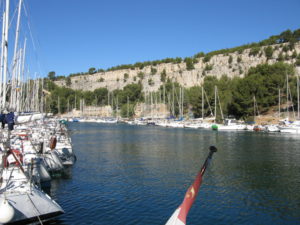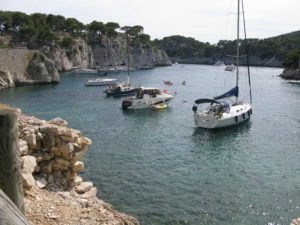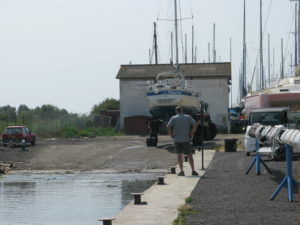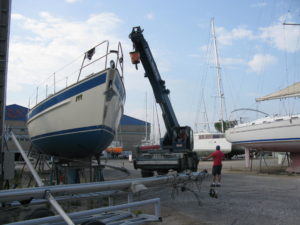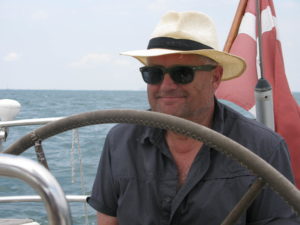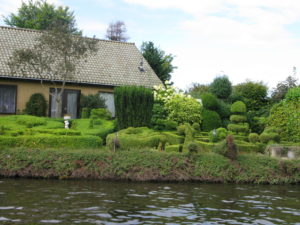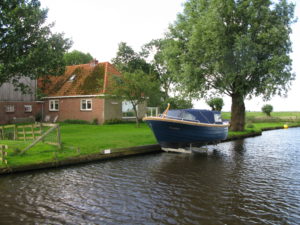Paradise on Earth – Calanque de Port-Miou
43° 12′ 20.16″ N, 5° 30′ 55.01″ E
July 5, 2016
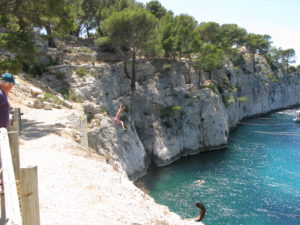 Until this day we had no idea, what a calanque was. We know that now. And we are excited. A calanque is a bay or – in the most exciting form – a narrow and deep fjord that cuts into a rocky
Until this day we had no idea, what a calanque was. We know that now. And we are excited. A calanque is a bay or – in the most exciting form – a narrow and deep fjord that cuts into a rocky 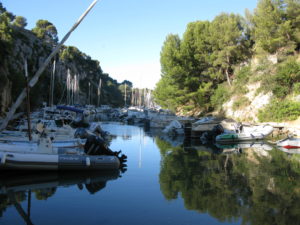 landscape, so the sides are almost vertical and can be up to 100 meters high.
landscape, so the sides are almost vertical and can be up to 100 meters high.
When you’re inside such a calanque, it feels a bit like sailing in a cathedral. Devoutly we look up and on the steep rock faces, enjoying the scent of pine trees and listening to the cicadas anthem. We sailed into them all, right from the first appeared a few miles after Marseille.
After checking all of them, we chose to settle down in – we think – the very most charming: Calangue de Port-Miou. Some calanques are boring, not much more than a wide cove with a blunt beach at the bottom. But the closer we get to the town of Cassis, the calanques are deeper and more characterful. First Sormiou, then Morgiou and later Calanque d’En Vau and Calanque de Port Pin. They are in their own way exciting. But none can compare with Calanque de Port-Miou.
At first glance it seems, that Port-Miou is just larger than the others with more places for mooring boats – with an anchor bend at one end and a rope wrapped around a rocky outcrop or, at best, a ring at the other end. But it is only at first glance.
Pout-Miou has a kind of anteroom, where there is room for 20-30 boats, and where there is a daily cruises from major cities nearby, where guides tell tourists about the calanques. But the trick is to proceed. Even into the bottom of the front room, for here is revealed 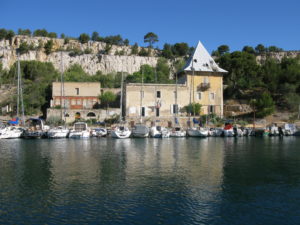 another room, much narrower, much longer, almost one kilometer long. On either side of this narrow space, there is built a “catwalk”, a slender wooden bridge, on both sides. And here hundreds of locals have their permanent mooring. As in a secret inner compartment.
another room, much narrower, much longer, almost one kilometer long. On either side of this narrow space, there is built a “catwalk”, a slender wooden bridge, on both sides. And here hundreds of locals have their permanent mooring. As in a secret inner compartment.
When we call the harbour master on channel 09 and ask for a berth, he refers us to the anteroom. We have no desire to go there. “We can see that there are berths available along the wooden bridges,” we insist. An inflatable boat shows up and we get assigned a berth. A wonderful place.
It is a small paradise. The water in the narrow canyon’s cold and clean and perfect to cool the body under the relentless sun. It is quiet. Not a sound from the tour boats in the front room. Only the cicadas. Occasionally a few kayakers or a single French man working on his boat.
Fact: It is primitive. But Frenchmen has an understanding for the value of beauty, so the price for an overnight stay in Port-Miou is the same as in Marseille, just over 35 €. And this is without electricity, far to the water connection and a 10 minute walk to the bathroom on the other side of the divide. Shopping is a 25-minute walk from Port-Miou in the town of Cassis. However, there are both bus and mini train, for those who do not bother walking.
Again in France, now Mediterranean
43° 23′ 15″ N, 4° 48′ 15.84″ E
June 29, 2016
Our driver is agitated. Why do those women not move their car so he can get past?
Fools! He opens the car window, shouting to the two women, that they should turn into a parking lot, so he can get past.
He did not quite understand the situation.
The two women backed out of their parking space exactly at the same time as our driver and they prepare to drive one way while he prepares to drive the other way. Now it is bumper to bumper. One woman gets out of the car and explains that this road is one-way, and that he is heading in the wrong direction. Therefore he must leave room for them to continue.
He snorts. Women. “Oh, la, la“. With his hand, he shows that these very women are impossible to explain to. “Je suis importante,” he said in a last attempt to win the match. “I am important.” It makes no impression. Our driver drives cursing back into position, leaving the women to pass and drives out again, while he mumbles about amateurs, women, people with no respect for authority and rules of the road.
Kirsten and I are sitting in the passenger seats and we see how the large arrow in the roadway show that it were the two women who were right. Our driver is a fool.
And we are back in France. Ready to resume our “circumnavigation in stages” on the good ship Ronja. A Swedish-built Malö 36, beautiful and solid. The past 11 months she has been parked on land 50 km west of Marseille. At Navy Service in Port Saint Louis du Rhone.
Our fool of a driver has just fetched us in the arrivals hall at Marseille airport with a sign from Navy Service: “Mr. Jensen “. It’s us. He is certainly 80+, looks like an angry Santa Claus with a white beard and rimless glasses, speaks only French and has probably exceeded the expiration date on his driver licence. When we came out from the arrival hall of the airport’s parking lot, he could not remember where he had put his car. Wait right here, he said and circled aimlessly.
Sigh. Who are we going to entrust our life here? He finds the car, we throw our two soft bags into the back – and then comes the two women and insist on their right. It’s not his day, this driver.
Navy Service is a great place. They have 1,200 boats in winter storage on land. They have specialized in lifting the ships on shore, park them and later – after several months – to put them in the water again. Others cannot. They operate cranes – boom cranes and ship cranes. And they are good.
In the living area – like some parasites – a dozen small independent craft businesses are operating. Some of these may prepare your engine for the winter, other repair epoxy damage, others can sew your storm- and cold- resistant nordic cockpit tent into a light and airy, Mediterranean-bimini. It is expensive. But damn it, it’s great.
I think it is a French specialty: Port du sec. Dry ports. Large paved or gravel areas where French and globetrotters leave their boats winter storage with masts on. It protects the boat against fouling, let them dry out and perfectly suited to those who still have only a sailing season of a few months.
Even with help from local craft people we sailors often forget, how much work it takes to make a sail boat ready to sail. The mast must be cleaned. Shroud and stays needs to be adjusted. Electrical installations between the mast and the boat must be restored. Bulbs should be changed. The drain should to be cleaned. Sails has to be put on. Defective parts replaced. Everything must have cleaning and polishing. Water and food should be stored.
It takes days. More time than anyone just walk around and remember. We get it all done, even if the sun above the Rhone delta is relentless. We prefer to work early morning and late evening, and at night we struggle with mosquitoes.
While we work we sometimes get a glimpse of our driver from the airport. He seems to function also as a worker in Navy Service. Today he drives a truck, moving containers and large bins with a tight-lipped expression.
No need to get in his way. None.
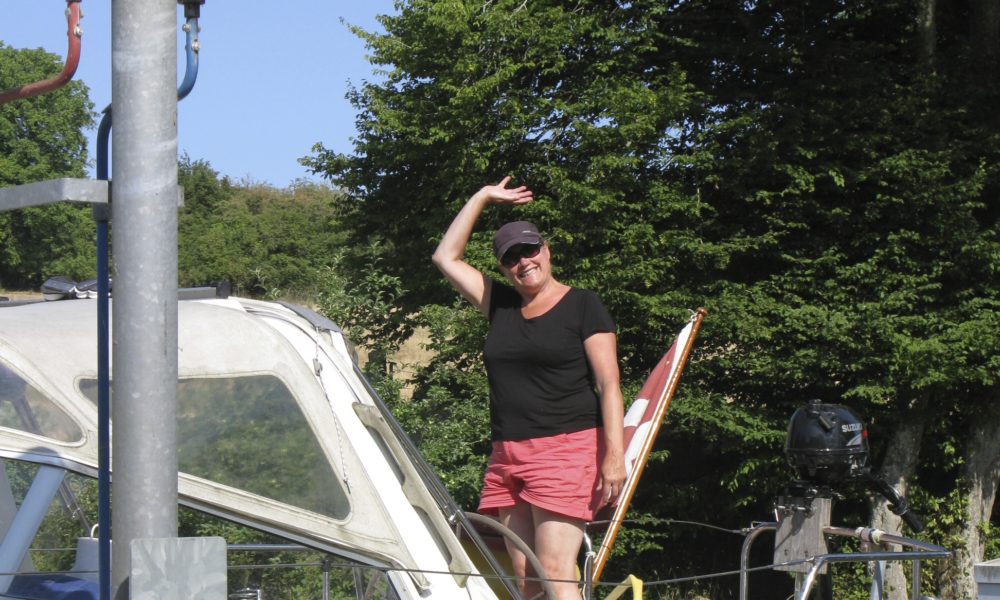
Farewell to Epernay. Hello to new adventures
49° 2′ 49.6348” N 3° 38′ 1.56” E
July 5, 2015
We have agreed with Monsieur Bernard, that we will sail at 9:00: He and his girlfriend are ready to wave good-bye at the quayside. He says tut-tut like a ferry, that departs from land, playing for Nellie and letting us know, that we have been some very special guests. Sure. In a port with a total of three boats, who winter there, we probably paid the lion’s share of his salary for a year, thinks a cynical man from Scandinavia.
It is a great trip. Damn it, it’s a relief to wave goodbye to Epernay, which has “bound us” for almost a year. Finally, we are back on track. Towards new adventures. Every day something new. The family spins. The motor hums pleasant. It was worth the wait. The new parts seem to be worth the money.
Log book: Today’s distance: 40 km. Sailed time: 10:10 a.m. to 17:00 = 7 hours. Locks: 8 pcs. Weather: Heat wave. Today, only up to 34 degrees to 36 degrees on Friday and Saturday.
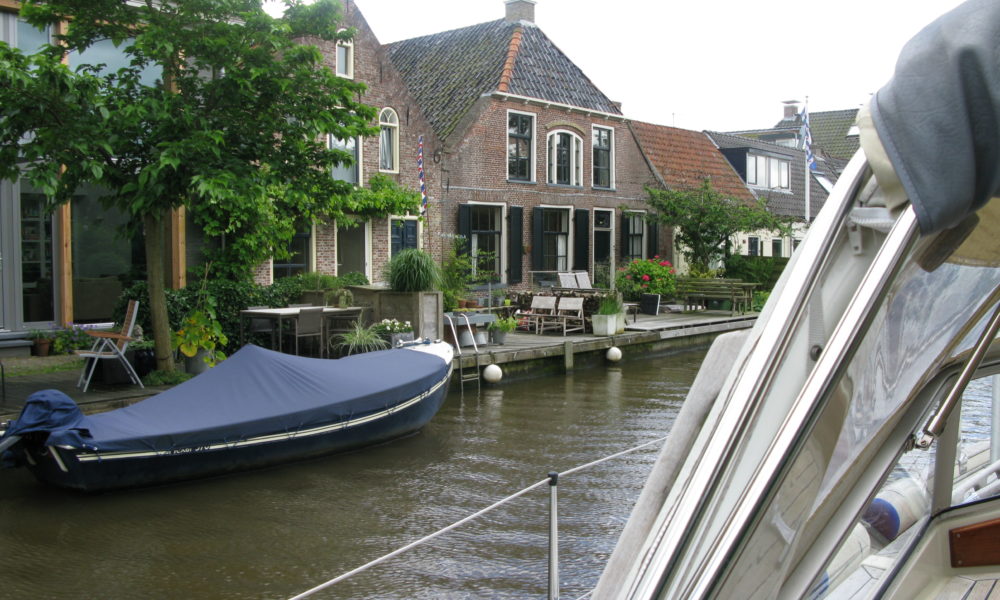
Sailing the Staande Mastroute in Holland
53° 19′ 51.6972” N 6° 55′ 28.056” E
After spending a few days on the German island Norderney we head towards Delfzilj. The city are chosen, because from here it is possible to sail “inside” Holland, through a system of channels, that you can pass with your mast still up.
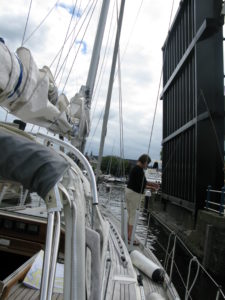
At some locks or bridges you pay a few euro in a wooden shoe from the end of a fishing rod
Five days – including two resting days – it took us to sail from Delfzilj to the great dutch lake called Ijselmeer. We passed 49 bridges and five locks. It worked perfectly. The bridges goes up, when we approach. As a rule. Sometimes we call via VHF. Some bridges charge a toll – five euro put in a wooden shoe, hanging from a fishing rod, which a bridge-employee lowers down towards us.
On our way we pass the one idyllic dutch town after another. The houses are located with manicured gardens facing the canal. The flowers are in full bloom, and on the edge a lot of boats are moored.
- In Holland you show your best to the waterside
- Every home has a boat
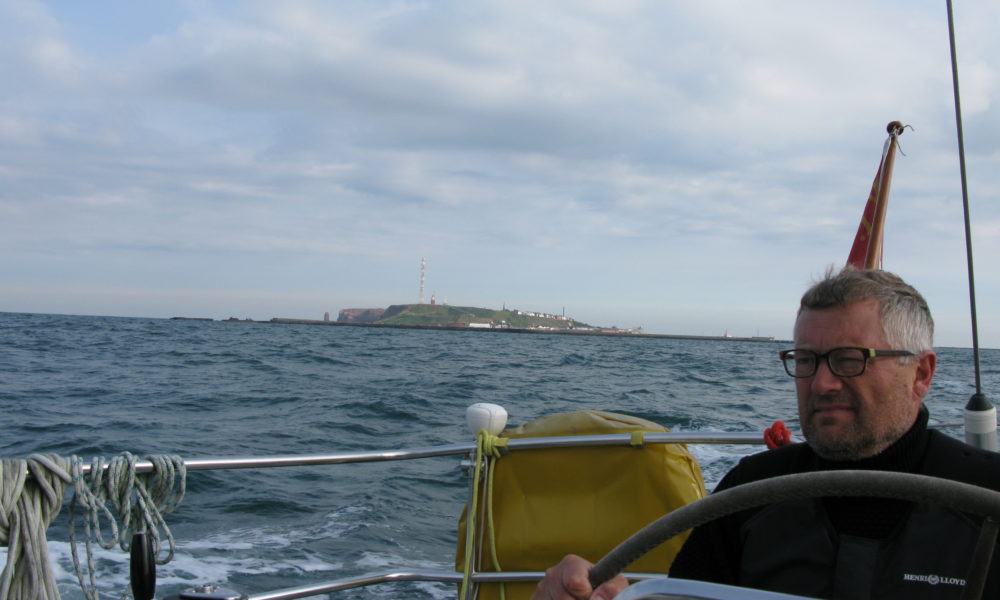
“Hold up” at sea. The police boards our boat and gives us a fine
53° 42′ 8.3748” N 7° 9′ 56.6201” E
Tuesday – July 13, 2012
Friday we decide to leave Helgoland heading for the Frisian island, Norderney.
The wind is against us again. But the weather forecast raised the prospect, that the wind will gradually turn during the day, and with the expectation of this we hoist the mainsail in the harbour of Helgoland, and then using the engine with the mainsail as stabilizing support sails we are ready to let the sail take over when the wind shifts.
We should not have done this.
The direct course towards Norderney brought us through not just one but two traffic separation zones, deep-water routes for large tankers and container ships. One for the river Jade, one for the river Elbe.
There was barely a ship in sight, those few who were, we knew exactly where were, so we “crossed” into the zone instead of taking the perscribed angle of 90 degrees. When such a zone is up to 10 km wide, you win both time and comfort by setting the direction after the wind and the goal instead of the regulations.
We should not at all have done this.
Far out on the horizon, we saw something that resembles a coastguard ship. When we saw it we turned on the VHF on channel 16 in order to hear any messages.
After a while, it looked as if the coastguard-ship had put a small boat in the water, and that this boat was heading towards us.
Damn it! There was no doubt. A high-speed inflatable boat was heading directly toward us. We turned Ronja into the wind, turned off the propellars and let the mainsail flap in the wind.
Shortly after, we were invoked. Four burly policemen in the dinghy. They let us understand, that they wanted to get on board. Very jovially. They joked that they needed lunch and slapped their stomachs.
It was not much about lunch. Two officers boarded Ronja. With pistols in their belts and a binder with forms and papers under the arm.
“We would like to explain why we are here,” they said. That is, the one spoke. The other took notes. “But first we’d like to see some documents – your passport, VHF license, proof of sailing education, nationality proof and evidence of ownership of the vessel.”
Luckily we had our documents under control, and when they subsequently asked for our charts, these were also OK. All charts were from 2012.
“We are here because we have observed, that you have crossed a traffic zone at an angle that differs 30 degrees from the rules of the sea,” said the officer.
He was absolutely right. We knew this in advance, and as if this were not enough, he brought a radar printout from the coastguard ship, where people apparently had followed us for a long time. “Here’s your course,” he said. “We called you on VHF pm. 10:32, but you did not answer”. This was before we turned the VHF on.
However this was only one thing. Then came the second. “We can look at course stability, that you both have had sails up and the engine on … It is only allowed under maritime law, if you with an inverted cone hoisted half up the mast shows that you are a sailing ship that is currently propelled to power” .
“Do you have a cone on board?” asked the officer.
“Certainly,” answered Per. “It is in the starboard bench.”
“Then you must draw it up now,” insisted the officer.
“Can’t we just take down the sail, so we are only motoring?”
“Your decision,” said the officer. And down came the sail.
“You have violated two rules. You will through your own authorities receive a fixed penalty notice of two or three hundred Euros. ”
Kirsten said that they should rather have said yes to get the lunch, which they themselves had proposed before they boarded us. The officers laughed politely and declined the offer. On the whole they were pretty professional. They did not go into discussions whether there had been any danger or any ships at all in the vicinity. They only focused on the fact, that two rules were violated.
They said goodbye and wished us a good journey, as they boarded their dinghy.
“Fucking German bureaucrats,” snorted Kirsten, when they were sailing away. “It is similar to getting a fine for ignoring a red light at a pedestrian crossing in the middle of the night, after having ensured that there is absolutely no traffic.”
Per was more relaxed over the incident. “We did something, we should not have done.” In his opinion, it was a fun and interesting experience.
The experience has led Kirsten, every time she sees a vessel that looks like a coastguard ship, to get a nervous twitch and to ask Per, if what we’re doing at the moment is actually completely legal.
After 12 hours rather good sailing – also with both sails up – we arrived in Norderney.
Log-book: Start of sailing 8.00. Destination: Norderney. Arrival 17.00.
